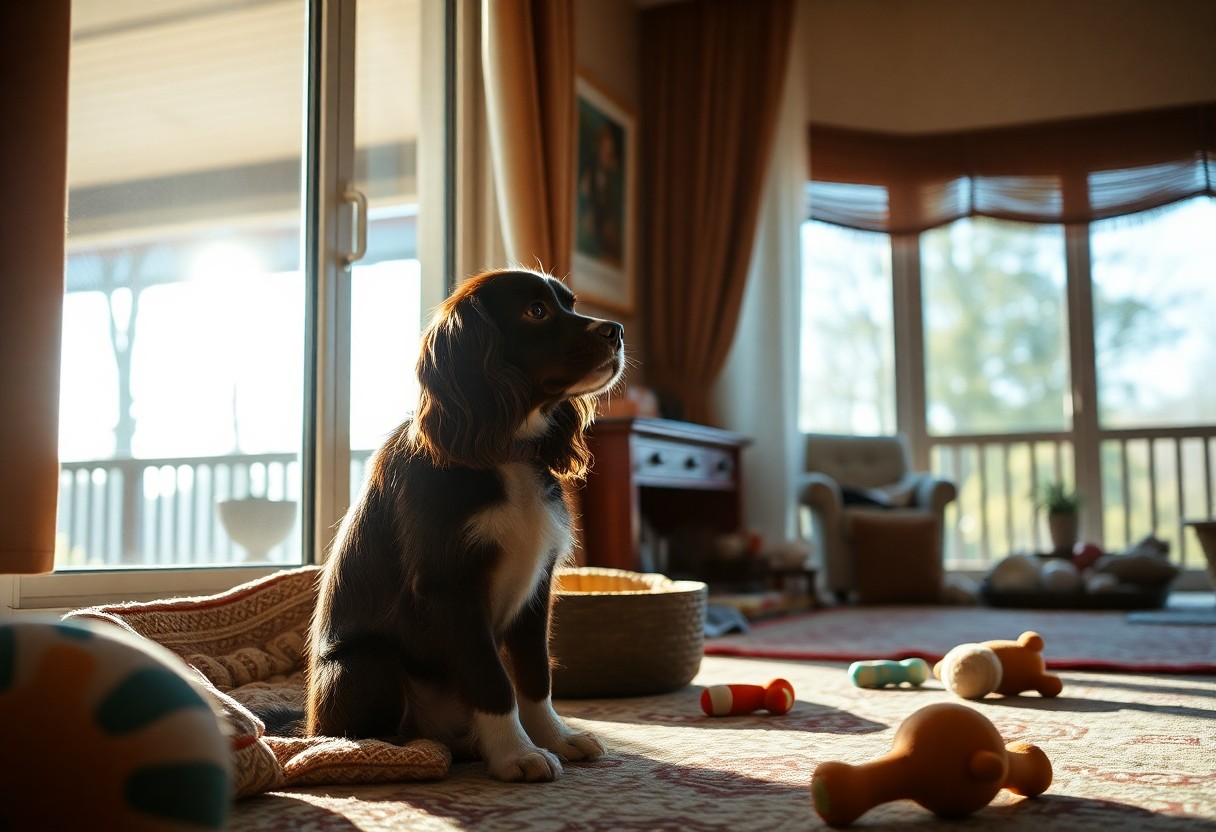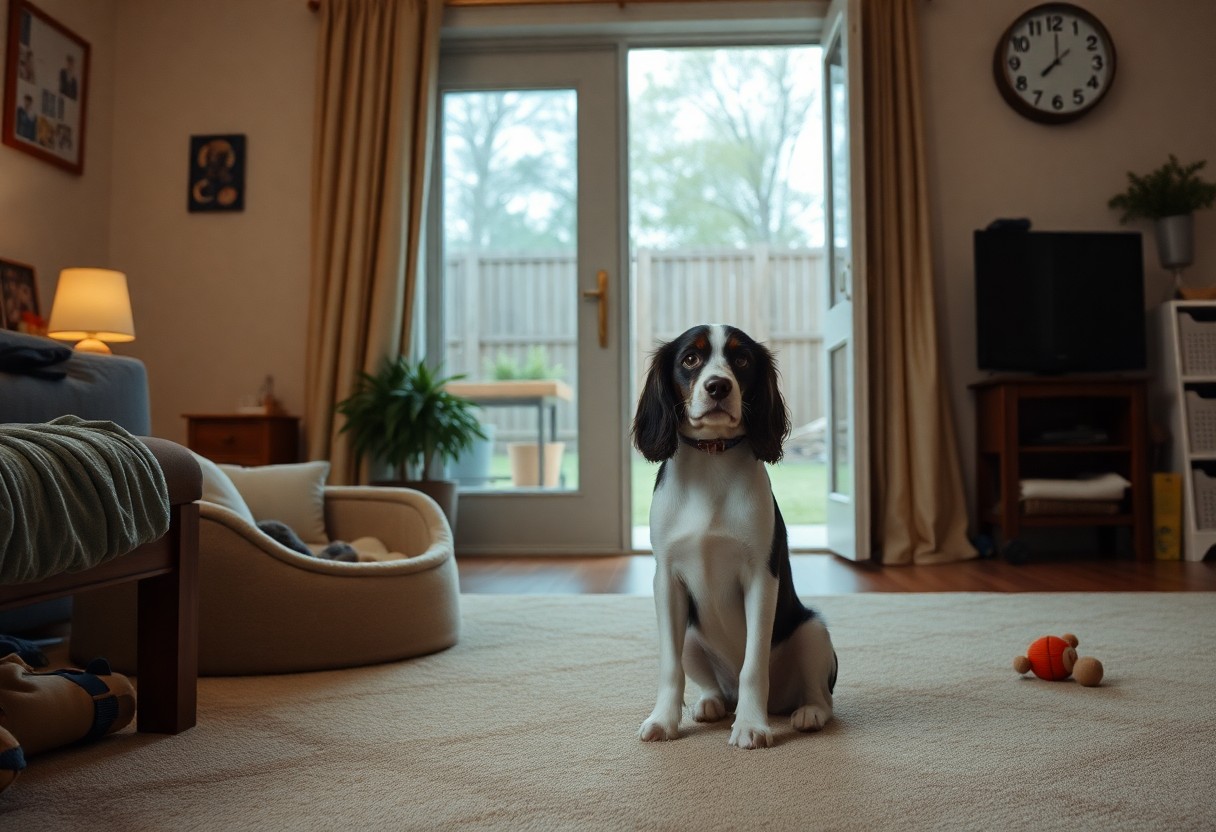Spaniels are affectionate and social dogs that thrive on companionship, which raises the question of whether you can leave them alone for extended periods. While some spaniels may handle solitude better than others, leaving them alone for too long can lead to anxiety, destructive behavior, and increased barking. It’s important to consider your individual dog’s needs, as well as how you can ensure a positive environment when they are alone, such as with proper training, engaging toys, and gradually increasing alone time. This post will help you navigate these considerations effectively.
Key Takeaways:
- Spaniels are social dogs and may experience separation anxiety if left alone for long periods.
- It is recommended to gradually train spaniels to become accustomed to being alone.
- Providing mental stimulation and physical activity before leaving them alone can help reduce stress.
- Short periods of alone time are generally acceptable for spaniels, but consistent long durations should be avoided.
- Setting up a safe and comfortable space with toys can help spaniels feel secure when left alone.
- Consider using pet cameras to monitor your spaniel’s well-being when you are away.
- Seeking help from a dog sitter or daycare can be beneficial for spaniels that struggle with solitude.
The Spaniel Personality Profile
Spaniels are renowned for their lively and engaging personalities. They tend to be affectionate, energetic, and eager to please, characteristics that endear them to families and make them excellent companions. Being social animals, they thrive on interaction, making it difficult for them to cope when left alone for extended periods. If you’re considering the implications of leaving your spaniel unattended, be sure to explore community experiences, such as those shared on forums discussing can a cocker spaniel puppy be left on its own for up to 5 hours.
Affectionate and Social Nature
With their loving demeanor, spaniels naturally seek companionship and thrive on human interaction. They often form strong bonds with their owners, displaying loyalty and joy in being part of family activities. Their friendly disposition makes them well-received by guests and other pets, underscoring their role as a true family member.
Potential for Separation Anxiety
Leaving spaniels alone may lead to signs of separation anxiety, causing distress not only in the dog but also complications for you. These dogs are known to vocalize, chew, or even develop destructive behaviours when their owners are away. Gradual desensitization and providing mental stimulation can help mitigate these behaviours.
Reducing the likelihood of separation anxiety involves understanding your spaniel’s triggers and adjusting their environment or routine accordingly. Start by gradually increasing the time they spend alone, creating positive associations with these experiences, such as leaving them with a favorite toy or treat. You may consider training a reliable “stay” command and investing in an interactive puzzle toy to keep them entertained. The aim is to foster confidence so they feel comfortable during your absences, minimizing the risk of stress or behaviour issues.
Assessing Your Spaniel’s Independence Level
Understanding your spaniel’s independence level is vital for determining how long you can comfortably leave them alone. This assessment involves evaluating their age, maturity, and individual temperament, all of which play significant roles in your spaniel’s ability to handle solitude without stress or anxiety.
Age and Maturity Considerations
As a general rule, younger spaniels, particularly puppies, require more attention and companionship than older, more mature dogs. Puppies may struggle with being alone for even short periods, often leading to destructive behaviors, while adult spaniels usually develop a greater sense of independence and can tolerate being left alone for longer durations.
Individual Temperament and Behavior
Your spaniel’s temperament has a significant impact on their ability to cope with alone time. Some spaniels may exhibit a calm disposition, while others can be naturally anxious. A relaxed spaniel might handle solitude well, while one prone to *separation anxiety* may necessitate additional support or training to stay comfortable.
Factors like past experiences, socialization levels, and genetics also contribute. A spaniel that was raised to be independent or one that has been exposed to various situations may fare better when left alone. Conversely, a spaniel that has relied heavily on companionship or struggles with change will likely exhibit discontent. Observing your spaniel’s reactions to different scenarios can provide insight into how well they might manage being left by themselves.
Preparing for Short Absences
Before leaving your spaniel alone, setting the stage for short absences can help minimize their stress. Gradually introducing them to alone time can aid in their acclimatization. During these intervals, ensure they have access to stimulating toys and a comfortable space. Start with brief absences and gradually increase the duration, allowing your dog to build confidence that you will return.
Gradual Desensitization Techniques
Begin by leaving your spaniel alone for just a few minutes, gradually extending the time as they grow more comfortable. Start with brief departures—perhaps stepping outside for five minutes—then return. Reinforce their calm behavior upon your return with treats or affection. This progression helps them associate your absences with positive experiences, rather than anxiety.
Safe and Engaging Environment Setup
Creating a secure and stimulating environment ensures your spaniel feels safe during your absence. Designate a cozy, confined area within your home that includes their bed and favorite toys. Engage their senses with chew toys or puzzle feeders that keep them occupied and mentally stimulated. Incorporating familiar scents, such as a piece of your clothing, can provide additional comfort while you are away.
A safe and engaging setup goes beyond just a few toys. Consider using interactive elements like treat-dispensing toys or a cozy blanket with your scent. Make sure the area is free from hazards, such as electrical cords or toxic plants. This safe zone should be a space your spaniel sees as comforting and entertaining. Regularly switch out toys to keep their interest piqued, ensuring they always have something new to explore. Providing a backdrop of soothing music or white noise can also help ease anxiety while you are out.
Strategies for Longer Alone Times
Managing longer periods of time away from your spaniel requires preparation and strategy. By employing various methods to keep your pup entertained and comfortable, you can alleviate anxiety and ensure their well-being while you are out. Integrating interactive toys and mental stimulation into your dog’s routine can help maintain their happiness, while utilizing pet services and support can provide that extra layer of care when you’re unable to be home.
Interactive Toys and Mental Stimulation
Offering interactive toys keeps your spaniel engaged and mentally fit while you’re away. Puzzle feeders that dispense treats as they solve challenges tap into your dog’s natural instincts. Look for toys that require problem-solving, such as treat-dispensing balls or toys that stimulate their hunting instincts. Providing these options can help reduce boredom and anxiety, contributing to your dog’s overall happiness.
Utilizing Pet Services and Support
Pet services such as dog walkers, pet sitters, or daycares can considerably ease the challenge of leaving your spaniel alone for extended periods. Hiring professionals not only ensures your pet receives companionship but also incorporates play and exercise into their day. Consider scheduling regular visits from a dog walker if you’re gone for several hours. Engaging with local pet services can create a reliable routine that promotes your spaniel’s emotional and physical health, ensuring they receive attention and care when you can’t be there.
For example, many pet-sitting services offer flexible options, such as drop-in visits or longer stays, tailored to fit your schedule. Research local providers, read reviews, and ask for recommendations. Establishing a consistent relationship with a pet sitter can also provide your spaniel with familiar faces and a routine, reducing their stress and anxiety levels. Similarly, daycare services offer social interaction and exercise, which are vital for your spaniel’s cooped-up energy during your absence. Balancing these services with interactive toys creates a comprehensive strategy for your spaniel’s well-being while you navigate your day-to-day responsibilities.
Distinguishing Signs of Stress and Well-Being
Recognizing the signs of stress and well-being in your spaniel can significantly improve their quality of life. Signs of a happy and relaxed dog often include a wagging tail, playful behavior, and relaxed body posture. In contrast, a stressed spaniel might display behaviors such as excessive barking, destructive chewing, or hiding. Understanding these indicators can help you create a more harmonious home environment. For further insights, check out Can a Cocker Spaniel Be Left Alone at Home? Our Vet ….
Key Indicators of Distress in Single-Home Spaniels
When left alone, your spaniel may show specific signs of distress, including increased whining or barking, pacing, and destructive behavior. They may also engage in excessive grooming or self-soothing actions, indicating anxiety or unease. Pay attention to changes in their appetite or sleeping patterns, as these can also signal elevated stress levels.
Monitoring Behavioral Changes Over Time
Observing your spaniel’s behavior over time offers valuable insights into their emotional state. Consistent patterns of stress or anxiety may emerge, allowing you to pinpoint triggers and adjust their environment or routine accordingly. Keeping a journal of their behaviors can reveal shifts that inform your training strategies, ensuring they feel secure when alone.
Regularly monitoring behavioral changes involves assessing your spaniel’s reactions to various situations, such as being left alone for varying durations. Document any signs of enthusiasm or distress upon your return, which can help you understand their emotional needs better. Noticing how their behavior evolves with training, environmental adjustments, or companionship will guide you in creating a comfortable atmosphere that minimizes stress for your pup.
Conclusion
Upon reflecting, it’s clear that leaving your spaniel alone requires careful consideration of their needs and temperament. While some spaniels may adapt to short absences, you should gradually train them to ensure they feel secure. If you find yourself needing to be away, explore options such as doggy daycare or a pet sitter for longer durations. For more insights, check this resource on Can you leave your English Cocker Spaniel alone? to help you make informed decisions for your furry companion.
Can Spaniels Be Left Alone?
Q: How long can a spaniel be left alone during the day?
A: Spaniels can typically be left alone for about 4 to 6 hours, depending on their age and personality. Puppies and younger spaniels might struggle with longer periods alone, while older ones may adapt better. It’s important to gradually acclimate them to solitude.
Q: What behavioral issues might arise if a spaniel is left alone too long?
A: If spaniels are left alone for extended periods, they may develop separation anxiety, leading to barking, howling, or destructive behavior. They can also become stressed, which may manifest as inappropriate elimination or obsessive behaviors.
Q: Are there specific things I can do to help my spaniel feel more comfortable alone?
A: To help your spaniel feel more comfortable when left alone, create a safe space with their favorite toys and bedding. You can also provide interactive toys or puzzles that keep them engaged. Consistent training and short departures can help them adjust over time.
Q: Should I consider getting a companion for my spaniel?
A: Getting another pet may be beneficial, especially if your spaniel is social and enjoys interaction. However, introducing a second pet should be done thoughtfully, ensuring both animals are compatible to prevent additional stress or jealousy.
Q: Is it safe to crate train a spaniel for when I’m away?
A: Yes, crate training can be safe and effective, as long as it is done correctly. The crate should be a comfortable space where the spaniel feels secure. Make sure they are not confined for too long, as this can lead to anxiety and discomfort.
Q: What signs indicate that a spaniel is struggling with being left alone?
A: Signs that your spaniel might be having difficulties include excessive barking, nighttime howling, chewing furniture, or showing signs of distress when you prepare to leave. Observing their behavior can help you gauge their comfort level.
Q: Can training help a spaniel learn to be left alone peacefully?
A: Training is very beneficial for helping a spaniel learn to be alone without stress. Gradual desensitization through positive reinforcement, along with teaching commands and providing routines, can build their confidence about being alone. Consultation with a professional trainer can also provide tailored strategies to help.


